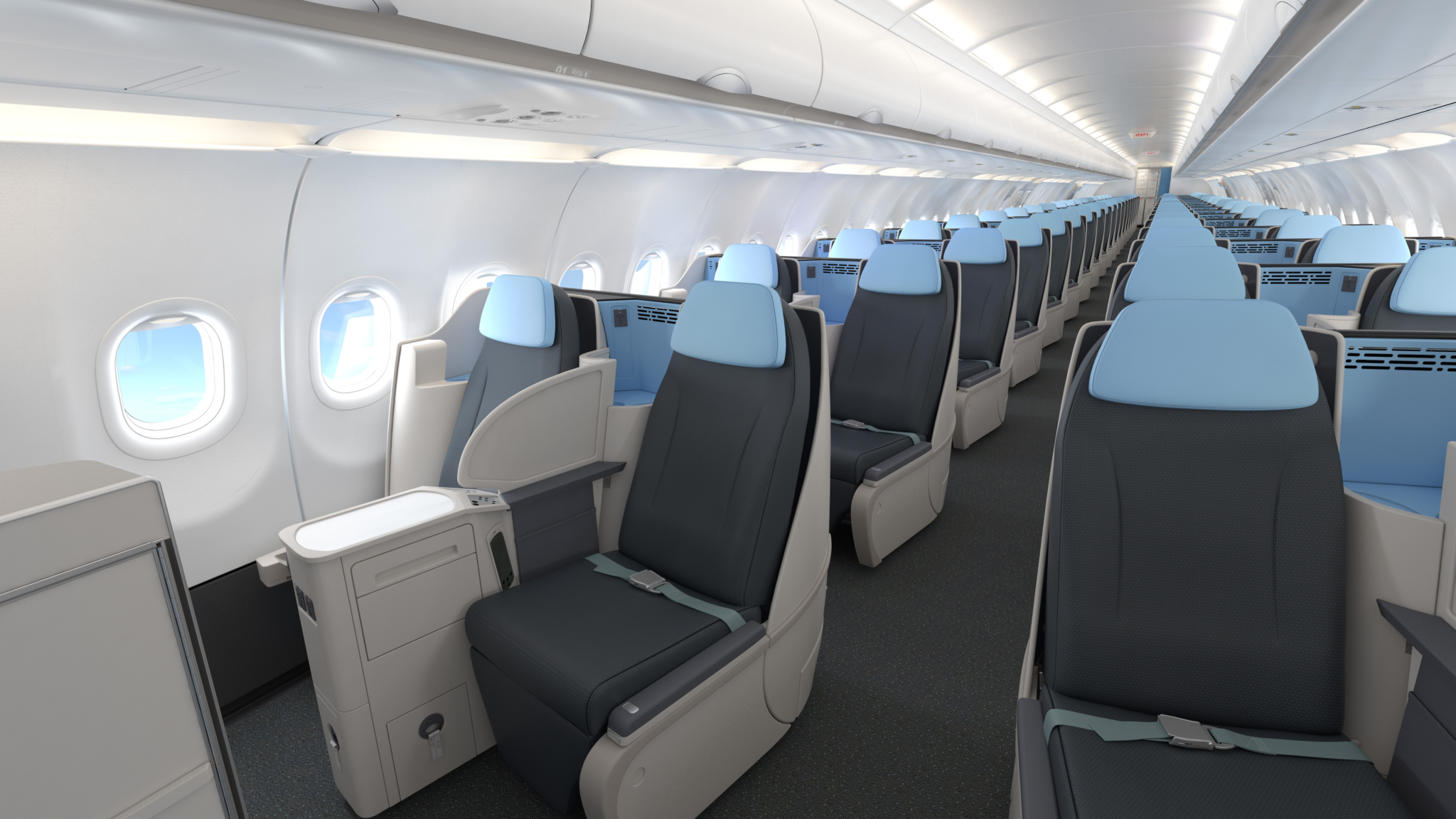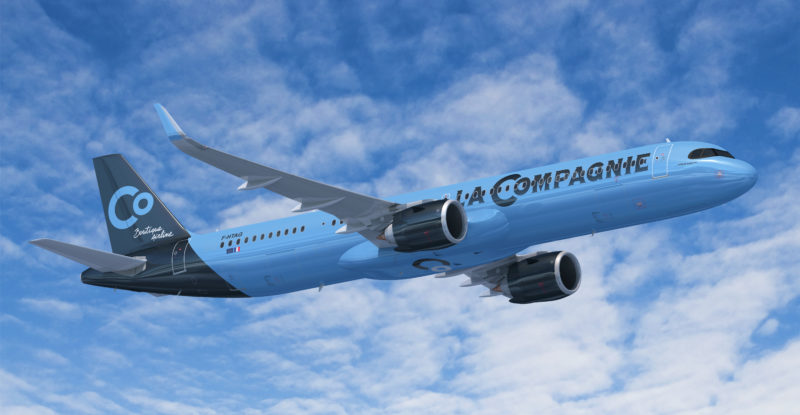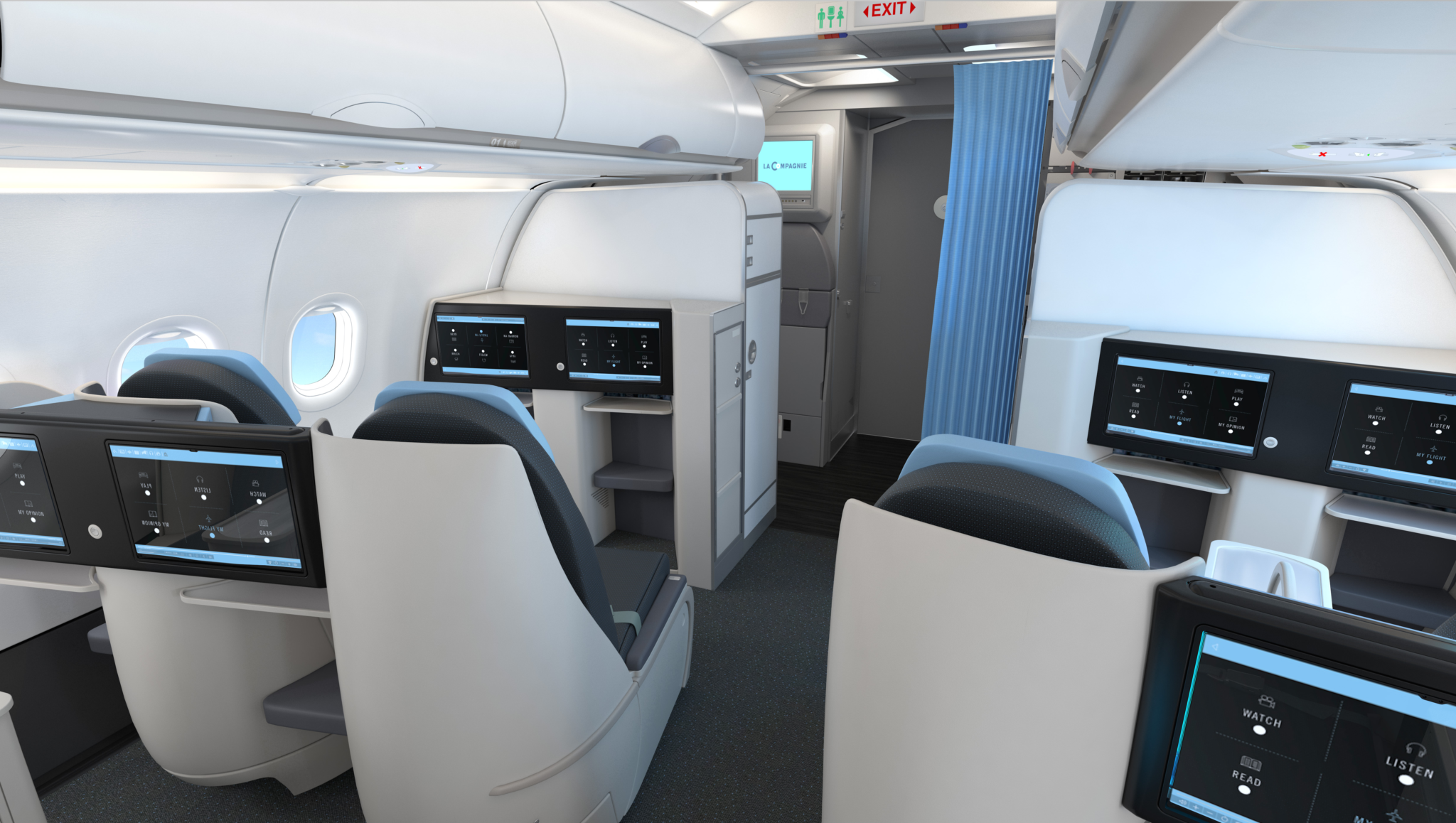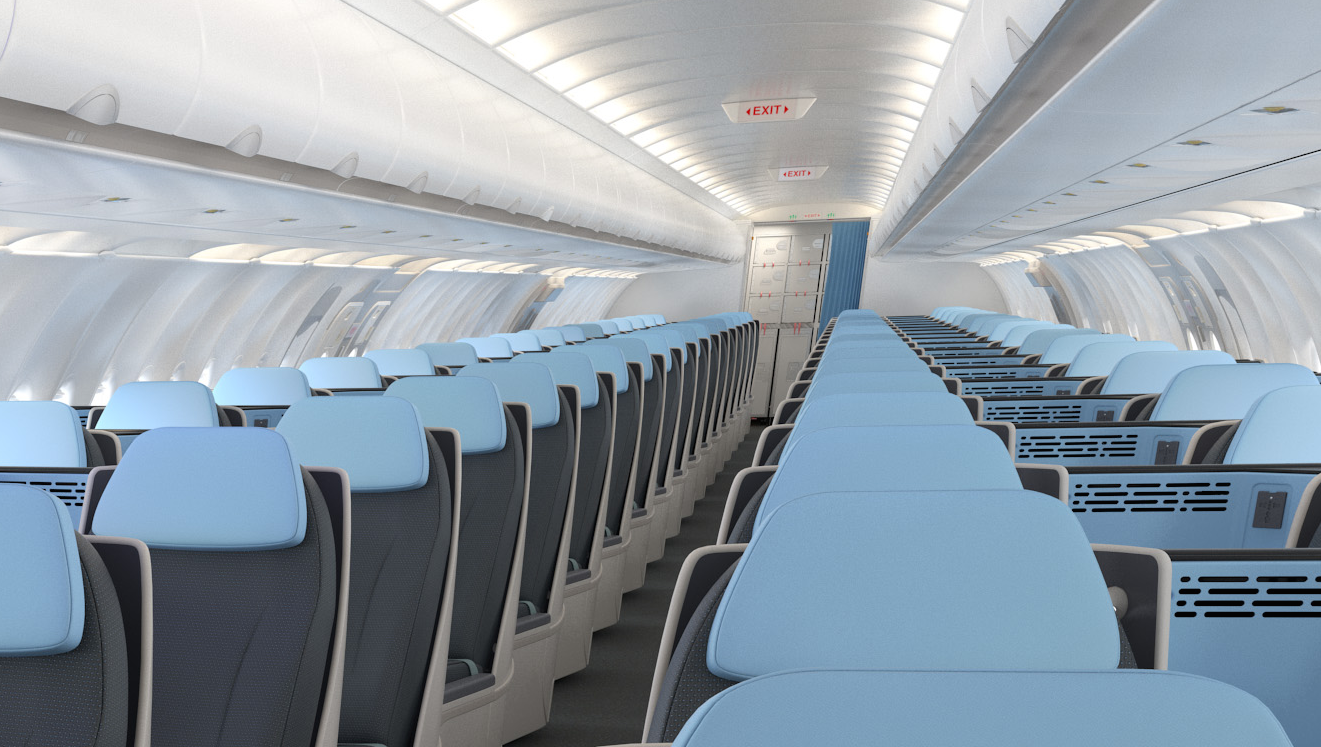 La Compagnie, the “boutique” (meaning “small”) all-business-class airline shuttling between Paris-Orly and Newark, is an unlikely survivor of the transatlantic bloodbath that just this week claimed Euro-LCC Primera Air. Yet the airline is reinvesting in the market with a new pair of aircraft, swapping two Boeing 757-200s for two Airbus A321neos and outfitting them with a fascinating mix of basic and top-notch passenger experience selections.
La Compagnie, the “boutique” (meaning “small”) all-business-class airline shuttling between Paris-Orly and Newark, is an unlikely survivor of the transatlantic bloodbath that just this week claimed Euro-LCC Primera Air. Yet the airline is reinvesting in the market with a new pair of aircraft, swapping two Boeing 757-200s for two Airbus A321neos and outfitting them with a fascinating mix of basic and top-notch passenger experience selections.
Let’s dive straight into the seats. Based on its CGI renders provided to the media, La Compagnie doesn’t appear to have taken advantage of any of the advances in the Rockwell Collins Diamond seat (for that is what it looks to be) in the more than a decade since its introduction to the market. Without confirmation from the parties, this appears to be a bargain basement specification of what is really one of the bare minimum products in any business class that hopes to be competitive these days. It is, however, a major upgrade from the angled lie-flat seats that look to me like the old blue Lufthansa Recaro sloping sleepers. Recaro could not immediately confirm whether this older seat was the 2003-era CL6510, but the design language and structure matches.
(I must also admit to looking rather askance that the airline named its seatmaker B/E Aerospace, a moniker that hasn’t been in use since the seating manufacturer was purchased by Rockwell early last year.)

One could hope for a little bit more luxe and imagination in the cabin or with the seat materials and finish. Image: La Compagnie
What’s interesting to me about the seat choice is that the Paris-New York budget business route has always been a sort of bottom of the barrel for passenger experience up front. Whether it’s Air France’s terrible old angled lie-flat sloping sleepers, the late lamented OpenSkies’ 2000-vintage British Airways Club World seats (the ones with the flappy fan, although updated slightly with power sockets and a tablet holder), or the current La Compagnie option, the PaxEx lacks any Parisian panache, elegance, or joie de vivre.
However, on OpenSkies and La Compagnie, at least, it was and remains cheap. Perhaps in the context of the demise of OpenSkies, Air France’s lack of an upgrade for its A380s, and United’s slow progress on Polaris, La Compagnie doesn’t think it needs to compete on the basis of its seat.
This is a reasonable position to take, since certainly it competes strongly on the basis of price, coming in at about 1800 euros return — when it’s not offering annual flight passes or regular two-for-one pricing. That’s roughly the price of premium economy on the network carriers with which it competes, and less than half of the other carriers’ business class flights on a series of dates I checked. On a seven-hour flight, the lack of direct aisle access is certainly worth that kind of saving.
In contrast with the seats, though, the company has gone for top-notch inflight entertainment hardware, since a Zodiac RAVE 15.7” monitor offers excellent screen quality and user interface these days, but of course the proof will be in the content selection pudding, both in entertainment quality and in picture quality.
Decent inflight connectivity is also on the cards, with the deal forming one of the first wins for ViaSat-2, which the satellite Internet service provider told me last week at the APEX Expo is performing well in tests, and that passengers can look forward to JetBlue levels of service. I wonder: is a two-aircraft installation the smallest-ever full fleet rollout of a commercial connectivity service agreement?
Returning to the seat, Diamond is one of the options that I’d expect a French cheap-and-cheerful leisure carrier to offer as its pointy end — compare with Air Caraïbes’ Stelia Equinox 3D — and indeed it wouldn’t surprise me if this were the start of a move by La Compagnie’s sister brand XL Airways to capitalise on the premium leisure market that many similar long-haul carriers are aiming to capture.
XL Airways currently operates the shockingly narrow nine-abreast Airbus A330 in what looks to me like an all-economy configuration — rather more XS than XL, really — and while there’s no premium product listed on the airline’s website I seem to remember they either have or used to have a row of recliners up front. It wouldn’t be that much of an investment to stick a row or two of Diamond at the front, sort of like what AirAsia X does with the Rockwell Minipod angled lie-flat seats, and charge a premium for just the hard product.
From a cost perspective, it’s interesting to see the combined XL-La Compagnie investing in the transatlantic brand, especially with stiff pricing competition from Norwegian (although that carrier’s approach to scheduling is not premium traveller friendly).
Indeed, I’m a little surprised not to see some sort of second cabin on the aircraft, in a way that might replace the hole in the market from OpenSkies, which operated three-class 757s with flatbeds, cradle sleepers and regular old economy seats, and which has been replaced by LEVEL’s premium economy and economy offering only.
On the aircraft side of things, after the late 2016 merger with XL Airways, having the combined carrier as an Airbus-only operator makes a lot of sense from an operational perspective. Airlines already cross-fleet their pilots and flight attendants to create efficiencies, and that might give the combined XL Airways Group the efficiency it needs. A very basic, well-established seat on an in-demand aircraft is a low-risk plan in the event that the airline’s strategy fails and La Compagnie is not the exception to the all-business-class demise trend.
And those two Boeing 757-200s La Compagnie currently operates aren’t getting any younger or more fuel efficient, even if they’re relatively sprightly 1994 and 2000 vintages. Their lessors can probably get a lot more out of them for those few routes that the A321neo can’t operate but that the 757 can.
That’s another interesting aspect: the press release mentions just “A321neo” and not “A321LR” aircraft. Does this mean that these new jets are the basic A321neo versions and not the extra-range A321LR aircraft? Neither Airbus nor La Compagnie responded to RGN’s requests for detail, and indeed the airline was quoted in French media last year saying it would not need the LR version, with the company’s Christian Vernet saying (in French), “We don’t need the A321LR for transatlantic. The A321neo consumes much less than the LR.”
It’s some 3649 nautical miles between Orly and Newark, which is at the upper end of the standard aircraft’s range. Clearly, 76 business class passengers will not tax the maximum takeoff weight of the A321, much as 74 of the older model didn’t stretch the 757-200. But for narrowbody operators keen to take advantage of the legs of the LR, this vote of confidence in the base model is a good sign — assuming it doesn’t need to stop in eastern Canada for fuel several times a year.
The renderings from Airbus also show the evolution of the Airbus Cabin-Flex layout, with a new and unusual option for the door layout. The current and previous versions of the A321 and -neo offered four doors, and the most frequently used Cabin-Flex layout in renders and in certification showed three doors plus two overwing exits.
The La Compagnie aircraft only shows one of the two overwings and just the aftmost exit door behind the wing. Inside the aircraft, Airbus offers a continuous interior wall to avoid any loss of floor footprint, although for the poor window seat passengers sitting next to the wall where the doors immediately after the wing used to be it’s not ideal. This Cabin-Flex development was not necessarily unexpected, but if you — like me — are watching the way the Cabin-Flex cards fall, it’s an interesting data point.
All in all, I am of course wary of drawing too many conclusions from such a small airline about seating, connectivity, airframe choices or much anything else, especially in the week that Primera Air went bust. But the re-upping on transatlantic all-biz, and the state of play on seats, wifi and entertainment, is all very much food for thought.
Related Articles:
- Dense flat seats tempt airlines towards better cheap business
- Scandi-LCC Primera Air takes aim at short transatlantic routes
- Lufthansa Group unveils staggered direct aisle access in business
- IAG LEVELs Paris, closes down OpenSkies
- United’s Zodiac Polaris 767 beats Vantage on American, Delta
- Lufthansa’s transatlantic redeye: the perils of relying on efficiency
- Eurowings unveils new old Lufthansa business class for longhaul?
- Recaro evolves CL6710 business class concepts into seat offer
- Airbus explains how Cabin-Flex enables dense A321neo layouts
- Press Release: La Compagnie to offer unlimited Viasat wifi on A321neos














